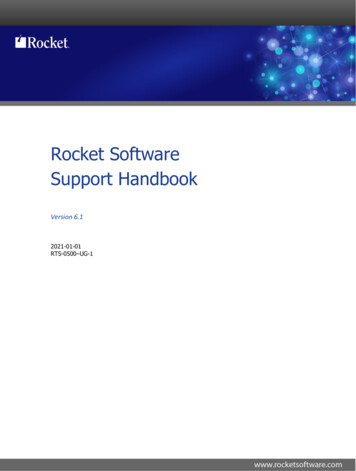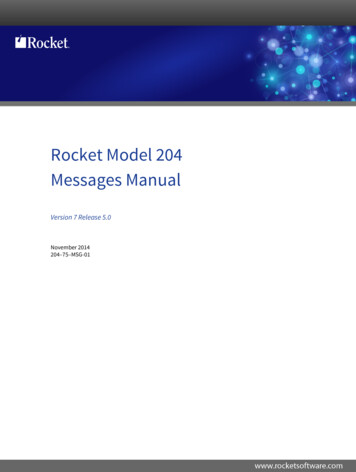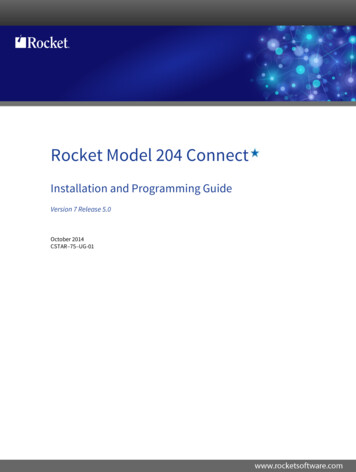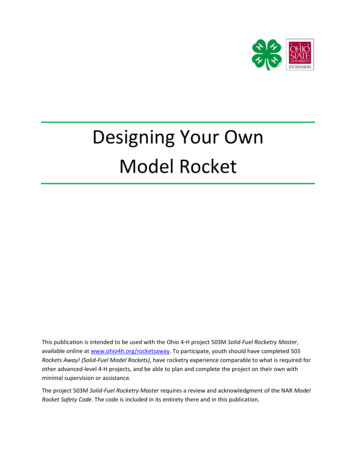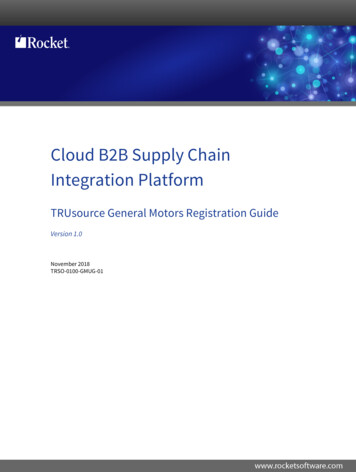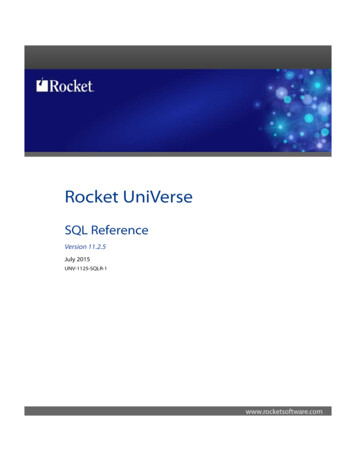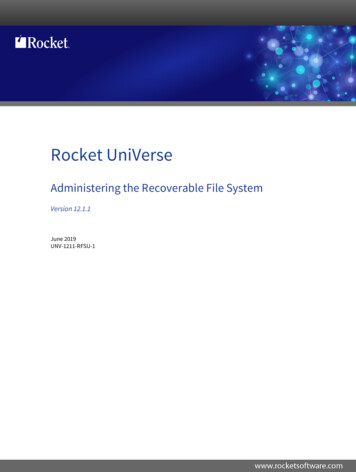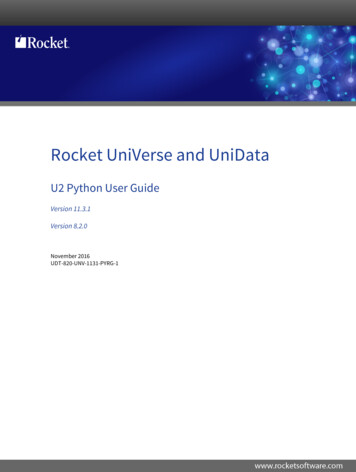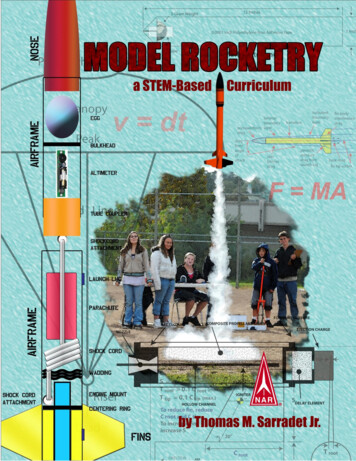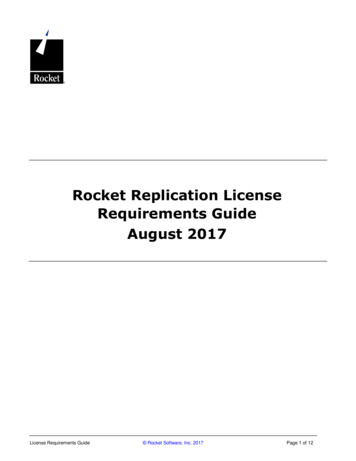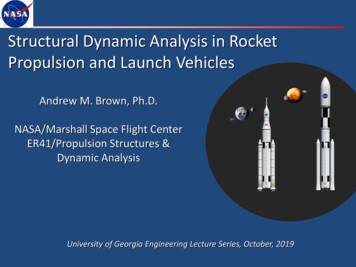
Transcription
Structural Dynamic Analysis in RocketPropulsion and Launch VehiclesAndrew M. Brown, Ph.D.NASA/Marshall Space Flight CenterER41/Propulsion Structures &Dynamic AnalysisUniversity ofSeries, October, 2019of Georgia Engineering Lecture Serles,
Agenda Introduction to NASA’s new SLS and Artemis Program to the Moon! Description of Structural Dynamics, and how it applies to a rocket. Application of Structural Dynamics in all phases of the mission of alaunch vehicle and its components:–––––Turbine Blades, Rocket NozzleRocket Engine LoadsHigh Cycle Fatigue in Main Propulsion SystemLaunch Vehicle Structural Dynamic Characterization and Test ValidationLaunch Vehicle Loads Will need to introduce various Structural Dynamics AnalysisMethods throughout presentation. Questions2
The Power of SLS and OrionORIONThe only spacecraft capable ofcarrying and sustaining crewon missions to deep space,providing emergency abortcapability, and safe re-entryfrom lunar return velocitiesSLS SLS Block 1 is 321 feethigh, 8.8 million lbthrust. 57,000 lbs to lunar orbit 100% more Payload.Volume, 50% more Massthan any other currentlaunch vehicle (includingSpaceX Falcon heavy).The only rocket with the powerand capability required to carryastronauts to deep SRaceonboard the Orion SP-ace.craft5 main sections joinedSep. 19, 20190663
Artemis Phase 1: To The Lunar Surface by 2024 '/2023" '· ·.· .-.Artemis II: First humans ,to orbit the Moon in the,21st centuryArtemis I: First humanspacecraft to the Moonin the 21st century2021Artemis SupportMission: Firsthigh-powerSolar ElectricPropulsion (SEP)systemArtemis SupportMission: Firstpressurizedmodule deliveredto GatewayArtemis Support "" -.··'Mission: Human.Landing Systemdelivered toGateway . 2024Artemis Ill:Crewed missionto Gateway andlunar surfaceCommercial Lunar Payload Services- CLPS-delivered science and technology payloadsEarly South Pole Mission(s)Large-Scale Cargo Lander- Increased capabilities for scienceand technology payloads- First robotic landing on eventual human lunarreturn and In-Situ Resource Utilization (ISRU) site- First ground truth of polar crater volatilesHumans on the Moon - 21st CenturyFirst crew leverages infrastructureleft behind by previous missionsLUNAR SOUTH POLE TARGET SITE0663
What is Structural Dynamics and Why do we care? What is Structural Dynamics?– Quantify dynamic characteristics of structures– Enable prediction of response of structures to dynamic environment– Assess uncertainties in predictions. Why do we care?– Excessive vibration can cause excessive deformation. Car noise, vibration, and harshnessTurbomachine rotordynamics (whirl)Computer disk drivesCutting machine chatterAstronaut eyeballs and other sensitive parts due to thrust oscillation.– Excessive vibration can cause structural failure due to high dynamic stresses. Turbine blades, other flow-path hardware Buildings under earthquake load– Any structure or system undergoing dynamic loading responds differently thanthat system undergoing static loading only, which may be good or bad. Space Vehicle loads Airplane control surfaces
Basics Free Vibration, Undamped Single Degree of Freedom Systemum Fx mumu Ku 01) Steady State, simplest, worth remembering:Assume solution u u(t) is of formu (t ) A cos(wt )u (t ) Aw sin(wt )u (t ) Aw 2 cos(wt )Now plug these equalities into eq of motion:m( Aw 2 cos wt ) k ( A cos wt ) 0A cos wt (k w 2 m) 0For A coswt 0, A has to 0 , i.e., no response (“trivial solution”)Therefore, k w 2 m 0kk Rad w secmmDefine l Eigenvalue w2 Natural Frequency2So, solution for u u(t) iswhere A depends on theinitial conditionsu (t ) A cos( mk t )w2 6
Frequency Response of Single Degree-of-Freedom(SDOF) SystemsAdd damping and forcing functionmu cu ku Fo cos( t )Critically damped ( 1)Define cccritical, if 1, underdampedt imewhereUnderdamped ( 1)c critical 2 k * m no oscillation in responseDynamic response as function of /w isU ( ) FoMagnification1k 2 2 1 2 w w 20 5 /wl1 5
Modal Analysis of Multiple DOF SystemsSolutions for Undamped, Free Vibration o f MDOF Systems with N dof's. mass M accel u stiffness K displacement u {0}Assume solution of form (I spatial solut ions eigenvectors modes)j (wit i ){u}i { }i eExamples: https://www.youtube.com/watch?v kvG7OrjBirIContinuousDiscrete MDOFw( x ) U i ( x ) { }i 1i 2ixu2i (t ) 2i e 4iw(x)u6iu4ij ( wi t i )u2itime 6i8
How a Rocket Engine Works, and why it needsStructural Dynamic Analysis Liquid Fuel (LH2,Kerosene) and Oxidizer(LO2) are stored in fueltanks at a fewatmospheres. Turbines, driven by hotgas created by minicombustors, tied withshaft to pump, suck inpropellants, increasestheir pressures tothousands of psi,producing substantialharmonic forces atspecific frequencies.E -- VePe - -V Velocity m mass flow ratep pressureExit - e-----ThroatThrust F mVe ( pe patm ) Ae High pressure propellants sent to Combustion Chamber, which ignites mixture with injectors,produces large forces in a wide band of frequencies, most of which are random. Hot gas directed to converging/diverging nozzle to give flow very high velocity for thrust. Both random and harmonic loads propagate through every component on the engine andlast throughout engine operation, requiring SD analysis to verify structural integrity.
Main Tool is Finite Element Analysis Discretize continuous structures into hundreds of thousands elements. Structural response of each element calculated by differential equation ofmotion. Can model very small turbine blades to complete launch vehicles.RS25 HighPressureFuelTurbineBladeAres IExperimentalLaunch Vehicle onPad10
Liftoff - Rocket Engine Structural Dynamics Structural Dynamics play a critical role in design of Turbomachinery,Nozzles, and System Hardware. (ignition 13 sec, vibration 44sec)),,'(,.,. \,-' ' ,1 ,. · . t I .:. . Ir, \.- ' i f:. ' IeIi\ 'I' 11
Structural Dynamics of Flowpath Components in TurbopumpsSSME/RS25 PowerheadTurbine Bladesparticularly problematicsince they have tremendous KE.TurbineBladed-DiskInlet Guide VanesStators
CFD needed to provide forcing functions Harmonic forcing function results from interaction of stationary and rotatingcomponents in flow-path. (wakes from upstream, potential field fromdownstream)CFD meshregion ofJ2Xfuel turbine13
Modal Analysis is first step in Turbine Bladed-DiskStructural Dynamic Analysis Identify natural frequencies and modeshapes, compare with frequencies offorcing functions. Try to avoid resonant conditions (“triplecrossover”) during design. If can’t avoid, frequently have to performforced response analysisPatran 2013 64-Bit 3 1-Oct-14 09:22:42Fringe : LP SP LO X PUMP TURBINE BUSK 51 ND . Mode 17: Freq . 84563 . Eigenvectors . Transl.lii .tt9Deform : LP SP LOX PUMP TURBINE BUSK 51ND . Mode 17:Freq. 84563 .ciefaulCFringe :Max 6.56 002 @Nd 3354EMin 4.41-010@Nd 22036default Deformation ·Max 6.56 002 @Nd 3354EFrame : 1. . DiagramJ2-S Fuel Turbopump 1st Stage Turbine Blade CampbellND 5; Excitation Order 74x 10 4.4mode ts4.2mode 144mode 12mode 1114
For Cyclically Symmetric Structures with Coupling,Identification of Nodal Diameters in Modes also Required Each blade mode on theprevious chart existswithin a familyassociated with bladedisk “Nodal Diameter”modes. The Tyler-Sofrin BladeVane Interaction Charttells us which NodalDiameter family of blademodes can be excited. E.G., 2 x Nozzlesexcites the 5NDfamily.5th Nodal Diameter Traveling Wave Modedefault Fringe :Max 2.81-003 @Nd 375Min -2.4 1-003 @Nd 101default D eformation :Max 2.81-003 @Nd 375LUpstreamNozzleMu lt iples3732N/A15
Modal Testing verifies Numerical Predictions Use Instrumented Impact Hammer to impart a quickimpact onto structure (force time history measured),which contains broadband frequency content (Fourier!). Response is measured using an accelerometer or laservibrometer, which measures velocity. A frequency analyzer performs Fourier Transforms of theexcitation and response to get frequency domain. Mode shapes obtained from ijm uiResponse at dof i Im FRFij ( ) FHarmonicexcitationatdofjj Match results with analysis, improve model (eg. SSME)16
Now, if resonance, forced response required, need to know aboutGeneralized Coordinates/Modal Superposition Frequency and Transient Response Analysis uses Concept of ModalSuperposition using Generalized (or Principal Coordinates). M ] u C ] u K ] u P(t ) Mode Superposition Method – transforms to set of uncoupled, SDOF equationsthat we can solve using SDOF methods. First obtain [F]mass. Now, introduce coordinate transformation:M u N F ] M M ] F ] C ] F ] K ] F ] P(t ) I\ ] C \ ] \ ] F ] P(t ) .T
Frequency Response of MDOF Systems can be Reduced toSolutions of multiple SDOF’s m F m (t ) lm T122 1 2 m wm wm 2H.OOE 04m35.00E i04· ,c,,4.00E i04m25;;'ii:e,u.5a:3.00E 04E E'.i:::e2.00E ,04t .OOE 04O.OOE 10030,00035,00040,00045,00050,000Fre11uem:y (Hz)rn27
For Example, Turbine Blade Forced Response ResultsWithout Damper,“combined 3s” 0.077%SFHCF 0.70Withoutexternaldamper Obtain alternating stresses during modalresonance. Combine with mean stress to give HighCycle Fatigue Safety Factor, SFHCF Analysis for AMDE blades showed ablade damper needed.W damperZeta .251%SFHCF 2.27
“Side Loads” in Rocket Nozzles is MajorFluid/Structural Dynamic Interaction Issue Start-up, shut-down, or sea-level testing of high-altitude engines,ambient pressure higher than internal nozzle wall pressures. During transient, pressure differential moves axially down nozzle. At critical pwall/pambient, flow separates from wall - Free ShockSeparation (FSS), induces “Side Load”.Mach number simulation from CFDFSSRSS
Calculation of Dynamic Forcing Function In-rushing ambient pressure at uneven axiallocations causes large transverse shock loadNet force onwallpambient Existing Side Load calculation method– Assumes separation at two different axialstations, integrates the resultant DP*dAloads. Method calibrated to maximum and minimumpossible separation locations to beintentionally conservative.pressure Caused failures of both nozzle actuatingsystems (Japanese H4 engine) and sections ofthe nozzle itself (SSME).pwallpw/pa .285Nozzle Axial LocationShocksMax Sep ratiopw/pa 0.5Min Sep ratiopw/pa .25
Primary Nozzle Failure Mode for most Rocket Engines isBuckling due to Side Loads during Start-Up and Shut-DownVulcainenginetest, DLRGermany
MSFC Side Loads Research Program - 1998 FASTRAC engine designed to operatein overexpanded condition duringground test. Didn’t have funding to pay for vacuumclamshell. Test/analysis program initiated withgoal of obtaining physics-based,predictable value. Strain-gauge measurements taken onnozzle during hot-fire test Flow separation clearly identified atSteady-State Operation.500400300µst rain20010000-1 0 0-2 0 0-3 0 0-4 0 0-5 0 0(\,I .306090120150180210240270300330VCircumferent ial locat ion ( deg)FASTRAC Hot-Firetest - Strain timehistories at 16circumferentiallocationsFlow Separation
Designed Cold-Flow Sub Scale Tests to investigate Fluid/StructureInteraction & Feedback during Steady-State Separation.F2 NodalDiameter ModeShape2.69 - 032.27-031.86-03S.Oe-O OZ1.44 - 033.Je-0021.03 - 036.12 - 041.97 - 04Pressure@ 16 D(135 )2ND mode(FE) @ 45hz Video, Pressure and strain-gage data from thin-wall nozzle showself-excited vibration loop tying structural 2ND mode and flowseparation.6.?e -003-2.0e-002-4.?e-002-7.Je-002-2.18 - 04-6.33- 04- 1.05- 03Straingage @135 600.000- 1.46-03300 .000- 1.88 - 03y- 2.29 - 03- 2.71 - 03- 3.12-03-300.000-600 .000pr37 3 sep07.dat Block S ize 4096. No o f Block 1 . BW 2.50. Time . 26.8 to 27.2000. Window-Type: None. - - - P. 3 7- 3 - '" p O? p" - l60 D R a w T ;me0 H;, 10 ,,, r.o . 26 .B D T 1 2, .7,,.2 0 - - - - - - - - -
Engine System Structural Dynamic Loads During steady-state operation, two types of dynamic force environments: sinusoidal(resulting from turbomachinery) and random (from combustion), which typicallydominate.Structural dynamic model of entire engine required to calculate response “loads”.With current level technology, impossible to quantify the forces with enoughprecision to conduct a true transient dynamic analysis.Methodology: measure dynamic environment (i.e., accelerations) at key locations inthe engine. For a new engine, data from “similar” previous engine designs is scaledto define an engine vibration environment ;:.ai(t)key locationsnear theprimaryvibrationsourcesa2(t).:rr. . .r,,11!.,. ,ISL .-.,. L-.o-.Vr"t-fJE-V'.,,.--.;:31-./ -4-,J., ,,.Ja'---'D-,c.-:.,:;. ,.(;h.J c:. . -. CSl.:r"tv.:c»uc.,s'A.Al(,,.,- 1.--·" · -- ,. . - - ooc .:::: -,-. · .: .:,;.:.:.- ::.::, - - " ., '"" " ""'":t: · ,: La1(t)J '- l \ .-- ' E E E """5elaj e;a l el aela6le Acceleration data isenveloped tocaptureuncertainties thusdefining a vibrationenvironment
Typical MC-1 Engine Load SetGlue Bracket 3GB-3Sine XSine YSine ZSine Peak (RSS)3 sig Random X3 sig Random Y3 sig Random ZRandom Peak (RSS)Shear 1(lbs)9791119178450781155915Shear 2(lbs)77511113661130Axial(lbs)00000000Bending 1(in-lbs)3325169419Bending 2625426938079Stringer Bracket 3 (Lower Support)SB-6Sine XSine YSine ZSine Peak (RSS)3 sig Random X3 sig Random Y3 sig Random ZRandom Peak (RSS)Stringer Bracket 3 (Upper Support)SB-5Sine XSine YSine ZSine Peak (RSS)3 sig Random X3 sig Random Y3 sig Random ZRandom Peak (RSS)
SD Analysis of Main Propulsion System – Antares https://www.youtube.com/watch?v FlqSxZQ7ji8 Oct. 28, 2014, Orbital ATK (now NorthrupGrumman) launched Antares-130 with ISScargo from Virginia. 15 seconds into flight, Main PropulsionSystem (engine and propellant feedlines)exploded. Damage to launch pad, noinjuries. MSFC called to help determine cause offailure. AJ26 Engine, actually an old Russian NK-33engine purchased by Aerojet with littleunderstanding of design.27
Very High Turbomachinery Vibration Levels Data taken on fuel propellant line close to tank showed very high acceleration levels, butunclear if that meant turbopumps themselves had excessive vibrations. MSFC Structural Dynamics team created/adapted finiteelement models of engines, feedlines, and tank, appliedloads at turbopumps and reproduced measuredresponse at accelerometer locations.Finite Element Modelof Main PropulsionSystem Conclusion: rotatingturbopump componentscontacted housing,rubbed, caused ignition(easy in LOX). Possible root causeswere manufacturingdefect, foreign objectdebris, or inadequateturbine-end bearings.28
2002 – Cracks found in Orbiter Main PropulsionSystem Feedline FlowlinerDownstreamGimbal JointLPFTP
Flowliner Dynamic Analysis ResultsUpstream FlowlinerAXIAL STRAIN CONTOUROutput Set: Mode 31 3136.425 HzContour: To Trans . X-Normal StraiHigh Gradient Dynamic analysis determined source of crackingwas several modes excited by upstream inducerblade count and cavitation. Tested flowliner dynamic response to validatemodels. Performed fracture analysis and computedexpected service life based upon observed cracksizes. Solution was improved and more frequentinspections.Complex Mode Shapes1000 to 4000 Hz
Launch Vehicle Loads Analysis (Coupled Loads Analysis) Purpose – calculate “gpa” (grid point accelerations) and resolved forces (shearsand moments) at all points along vehicle structure during all phases of mission.These are generically called “loads”. First must generate estimates of forces on vehicle– Transportation forces – ground, shipping– Launch – vibroacoustics (acoustic waves from engines rebounding off of launch area back ontovehicle structure)– Ascent – wind and aerodynamic forces– Thrust from Engines– Stage Separation & Pyrotechnic Events Then calculate Structural Dynamic Response– “Coupled Loads Analysis” using “Component Mode Synthesis” primary technique Outputs–––––Random Vibration & Shock CriteriaComponent AccelerationsDesign Limit LoadsAeroelasticity AssessmentsPropellant Slosh Dynamics
SLS Europa Clipper Configuration –Y & Z Bending & Axial Modes Comparison - Liftoff1 SM1 Block1 Liftoff TO F100 Delivery 2- Mocfe 3'f1 SM1 Block1 Liftoff TO F100 Delivery 2- Mocfe 321.4829 Hz1.4937 HzScale : 5000xRigid wall representation of centerline shapeScale: 5000xRigid wall representation of centerline shape1 SM1 Block1 Liftoff TO F100 Delivery 23-,- Mocfe 35-1 SM1 Block1 Liftoff TO F100 Delivery 2- Mocfe 34LiftoffVehicleMode Number Freq (Hz)Mode ShapeDAC1 SM-1311.481st Y-BendingDAC1 SM-1321.491st Z-BendingDAC1 SM-1352.092nd Y-BendingDAC1 SM-1342.012nd Z-BendingDAC1 SM-11149.95Axial (ICPS CS)*VAC1R EM-1301.361st Y-BendingVAC1R EM-1321.41st Z-BendingVAC1R EM-1392.42nd Y-BendingVAC1R EM-1372.252nd Z-BendingVAC1R EM-112610.42Axial 1 (CS)VAC1R EM-114311.16 Axial 2 (MPCV ICPS)*Additional verification of this mode performed (see backup)SL S DAC1 SM1 Block1 Lltoff T0 F1 OO Delivery 23-J an-20192.0909 Hz2.0106 HzScale : 5000xRigid wall representation of centerline shapeScale: 5000xRigid wall representation of centerline shapeMode 11 49.9522 HzScale : SOOOxRigid wall re presentation of cen te rlin e shap e32
Coupled Loads Cycles When Aerodynamic, Inertial, and other external forces applied toStructural Dynamic model and “Loads” (Shear X, Y, Z, Bending MomentX, Y, Z) obtained, used for design updates.CORE: XSHEAR- - SLS 1001 1 PMAC1 LO. IG- - SLS 10507 DAC 1 SM1 LO .IG- - 045 RevD Liftoff Limits tion [in)33
First 3 SLS Vehicle fundamental modes driveprimary structure loads The first 3 bendingmode pairs alsorepresent the mostimportant modes forGNC stability. The beam-like responseof SLS at lowfrequencies increasesthe likelihood ofaccurately capturingthese modes during theIntegrated Modal Test.VAC1 R WLSLIV Ascent Max/Min Mode Contributions120 - - - - - - - - - - - - - - - - - - - - - **-100Modal Load Indicator SLS Primary Structureloads are dominated bythe first 3 bendingmode 530Page 34
Component Mode Synthesis is Theory behind Coupled Loads Used to dynamically couple together “substructures” built by different organizations. Partition displacement vectors into internal and boundary DOF’s. xinternal x boundary orbiter x , i xb ET x , i xb SRB1 x , i xb SRB 2 x , i xb satellitetrunions35
Solution of CMS using Craig-Bampton TransformationPartition M and K matrices of each substructure in same way: M ]ET M ii M biM ib M bb ET K ]andET K ii K biK ib K bb ETCraig-Bampton Transformation Matrix [CB] ET ui ub M ]system [CB]ETTT M ] [CB]ET K ]system [CB]ET K ]T F cantilevered 0 ETETET[CB ]ET {F }system [CB]ET {F (t )}ET K iiET K ibET I 1 [CB ]orbiter [CB ]orbiterTT M ]orbiter K ]orbiter ub ET[CB ]orbiter[CB ]orbiter systemT [CB]ET {F (t )}orbiternow solve M ]sys sys [ B]sys sys K ]sys { }sys F sysas you would any other MDOF system.i.e., transform to generalized coordinates using new system matrices toobtain uncoupled equations of motion in { }, solve time responsenumerically, back transform to { }sys , back transform again to get {u}. orbiter ET satellite orb ET ub
Artemis-1 Dynamic Testing to Validate ModelsCore StageModalML Only(6 VAB MM)Booster PullPSMTIMTZ PullIdentifies key modalproperties of the CS Includes stand-alonecrane testing tostudy boundaryIdentifies key modalproperties of the ML Tower Platform Mount MechIdentifies interface stiffnessSLS/ML Aft skirt VSP Haunch/Girder1st dynamic test of SLSelements on ML. Dynamic validationof static I/F stiffnessfrom previous testFully Integrated VehicleModel of SLS/ML SLS dynamics should beprimary unknown inthis test. Data feeds the tunedBME (Best ModelEstimate) Each test builds upon the previous test results What is the probability that the flight model is “good”, given thatverification is only done on the ground?37
Conclusion Structural Dynamics is one of the Critical Disciplines for thesuccessful Design, Development, & Testing of Space LaunchVehicles. It is applied from the smallest component (turbine blades), all theway to the entire vehicle, and has to be calculated for everyphase of a mission, from ascent and orbit to landing. Successful application of Structural Dynamics requires extensiveknowledge of Fourier Techniques, Linear Algebra, RandomVariables, Finite Element Modeling, and essentials of SDOF andMDOF vibration theory. Working knowledge of Fluid Dynamics, Statistics, and DataAnalysis also extremely useful. This is fun!38
Modal Analysis is first step in Turbine Bladed-Disk Structural Dynamic Analysis 14 Identify natural frequencies and mode shapes, compare with frequencies of forcing functions. Try to avoid resonant conditions ("triple crossover") during design. If can't avoid, frequently have to perform forced response analysis
